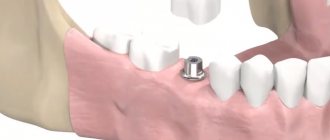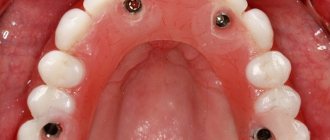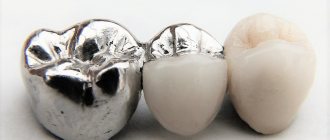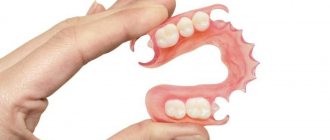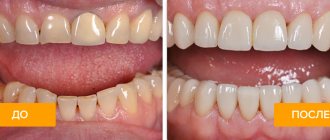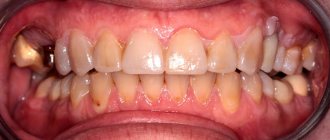From this article you will learn:
- how to improve the fixation of complete removable dentures,
- types of overdentures, reviews,
- price for 2021.
Conditionally removable (covering) dentures are a type of dental prosthetics in the complete absence of teeth, when several dental implants are installed under a removable denture in order to improve its fixation on a toothless jaw. Fixation of such prostheses to implants installed in the bone tissue of the jaws is carried out using special locking fasteners. Such attachments can be push-button or bar-type, for example, through ball-shaped abutments, Locator® equatorial abutments, and cast or milled bars (Fig. 1-3).
Dentures of this type are called “conditionally removable” in dentistry for the reason that you can only remove such a denture if you apply sufficient force. However, patients more often call them by the term “overdentures”. Their biggest advantage is that they never fall off while talking or chewing. It should also be noted that dentures of this type can be used not only with complete, but also sometimes with partial absence of teeth.
Conditionally removable prosthesis: photo
* The minimum cost of a conditionally removable prosthesis on implants will start from 100,000 rubles (detailed options for prostheses and prices - see below).
Advantages of conditionally removable dentures –
Traditional removable dentures made of ordinary acrylic plastic are very poorly fixed on toothless jaws. This is due to the fact that under removable dentures, atrophy of the alveolar processes of the jaws (on which the denture “sits”) gradually occurs. This leads to a gradual decrease in the height and width of the alveolar processes - in proportion to this, the fixation of the prosthesis worsens.
Advantages of dentures on implants -
- excellent fixation even with severe bone atrophy,
- immediate prosthetics,
- comfort - such dentures have a smaller plastic base (on the upper jaw the denture is made with virtually no overlap of the palate),
- relatively affordable price.
Conditionally removable prosthesis on implants: reviews
We have already said above that conditionally removable dentures on implants are fixed using special locking fasteners. Half of each such lock is screwed into the implants and protrudes above the surface of the gum mucosa, and the second half is installed in the base of the denture (in the projection of the installed implants).
When putting on the prosthesis, the parts of the locking fasteners are connected and the prosthesis is securely held. To then remove such a prosthesis, you need to apply a force equal to an approximate lifting of a mass from 400 to 2000 grams (depending on the type of attachment). An overdenture can have several types of fixation to implants, which we will describe in detail below...
Dentures for completely edentulous upper jaw
Up to 8 implants are implanted into the jawbone from above, since the bone here is loose and subject to atrophy (compared to the lower jaw). In some cases, removable prosthetics of the upper jaw are organized on 4-6 implants, if the density and size of the bone allows.
If there is a significant deficiency of bone tissue, there is a risk of injury to the maxillary sinuses, then a sinus lift is performed first or mini-implants are used.
Mini-sized artificial roots are not the best option for fixing removable dentures on the upper jaw. Titanium roots will not stick to loose fabric. If mini-products are implanted, the Locator fixing mechanism is used.
Prostheses with push-button fixation –
At the first stage, implants are installed in the jaw, the number of which will depend both on their diameter and on whether prosthetics will be performed on the upper or lower jaw. In the upper jaw, 4 implants are usually installed - regardless of their diameter, which is due to the presence of a softer type of bone in the upper jaw.
On the lower jaw, if mini-implants (1.8-2.4 mm in diameter) are used, 4 of them are also installed. Moreover, the use of implants of such a small diameter allows you to almost always avoid bone grafting - if the patient has thin alveolar shoot. However, if implants with a diameter of 4-5 mm are used, only 2 of them can be installed, but 3-4 are still better, because this will improve the stability of the prosthesis.
Prosthesis fixation system - after installing the implants, abutments are screwed into them, which will protrude above the surface of the mucous membrane and serve as an element for fixing the prosthesis. For these purposes, two types of abutments can be used: spherical or equatorial. Which type of fixation (using which abutments) is better – we explain in detail below.
1) Fixation on ball-shaped abutments –
Below we show a diagram of fixing a removable denture on ball-type abutments. You will find a detailed description below.
After installing the implants, abutments are screwed into them (or the implants may already have permanent abutments). Externally, the spherical abutment looks like a metal ball-shaped head protruding above the mucous membrane (Fig. 4). Such spherical abutments are the first half of the mechanism for fixing a removable denture on implants. The second half of the locking fastening is located in the base of the prosthesis.
In the projection of each implant with a spherical abutment, a recess is made in the base of the prosthesis into which a metal holder for a silicone matrix is inserted, of course, along with the matrix itself. The silicone matrix is something like a rubber sealing ring (Fig. 5). When putting on the prosthesis, the head of the ball-shaped abutment passes through this ring, which then tightly holds the abutment (Fig. 6). After this, the prosthesis can be removed only by applying sufficient force.
Fixation of the prosthesis on ball-shaped abutments: photo
Important: the big disadvantage of the fixation system on ball-shaped abutments is that they tend to wear out as a result of friction in about 2-3 years. As a result, the abutment head becomes flatter and the silicone matrix holds it less and less well. That is why it is worth installing only those implants in which the ball-shaped abutment can be replaced with a new one.
If you install implants that already have permanent abutments, then in order to replace them, you will simply have to install the implants again. To reduce the rate of wear, some companies coat the abutments with special coatings, but this is still not a long-term solution to this problem.
2) Fixation on equatorial abutments (Locator®) –
This fixation system is called Locator® (Fig. 13-15).
For patients, it is more comfortable in terms of removing and putting on a removable denture, and also allows them to visit the dentist less often to service the prosthesis fixation system. It allows implant surgeons to place implants in the jaw at large angles relative to each other, which is necessary in case of severe atrophy of the jaw bone tissue. Equator abutments differ from spherical abutments in their shape, which affects the nature of the interaction between the abutment and the silicone matrix. With this system, a holder for the matrix is also built into the base of the removable denture (along with the silicone matrix itself) - in the projection of each installed implant with an abutment. Equator abutment dentures are more comfortable and require less maintenance.
Fixation of the prosthesis on the equatorial abdomen: photo
Features of prosthetics with prostheses with push-button type of fixation –
The manufacture of a prosthesis, both when using spherical and equatorial abutments, in most cases can be carried out immediately after surgery (especially on the lower jaw). Those. Impressions will be taken immediately and within a few days a prosthesis will be made from either regular acrylic plastic or slightly elastic Acry-free material (this option will be more expensive).
However, if you already have a prosthesis (provided that it is well made and is no more than 2 years old), you will be able to use your old prosthesis without making a new one. To do this, recesses will be made in your old prosthesis and locking fasteners - silicone matrices - will be installed there.
Advantages of push-button type fixation:
- technical ease of manufacture,
- more affordable price,
- implants with push-button fastening can be installed even under an old prosthesis,
- simpler hygiene (less risk of inflammation around implants in the future).
Disadvantages of push-button type locking –
- Weakening of the fixation over time requires periodic replacement of silicone matrices, and in the case of spherical abutments, the matrices will have to be changed several times more often - approximately once every six months (compared to the use of equatorial abutments, where the matrices are changed less frequently).
Overdentures with fixation “Locator”: video
All the disadvantages of all-on-4
The implantation technique has many advantages, but a few disadvantages are discussed on forums and in reviews. Among them, obvious, individual, and also invented ones stand out.
Disadvantages of all-on-4: classic
The obvious disadvantages of all-on-4 include:
- The need to find a good dental clinic. The original all-on-4 protocol requires paying increased attention to equipment and having the appropriate software, tools, and materials available. If alternative preparation methods are used in dentistry, there is a risk of deterioration in the quality of the service provided. It is not a disadvantage to choose among several brands of dental implants rather than a total installation of Nobel Biocare, since in this case the patient selects treatment according to his financial capabilities.
- Search for an experienced implant dentist. The doctor’s experience is more important than the material resources of the chosen dentistry. A good doctor not only thoroughly knows the features of the chosen brand of dental implants for all-on-4, but is also ready to quickly make smart decisions. Rating lists of specialized dentists in Moscow, patient reviews, and recommendations from friends help you choose an implantologist.
- Price. All-on-4 prosthetics seems financially expensive. Especially in comparison with the manufacture of removable dentures. But a comparison of long-term costs, wearing comfort and other factors indicate the benefits of installing teeth “all on 4 implants.”
- Payment for two prostheses instead of one. The classic all-on-4 protocol obliges the doctor to immediately install a temporary denture, which is replaced with a permanent one after several years of wear. The patient pays for both designs, which often seems like a bad decision. But there are benefits - the presence of teeth immediately after implantation surgery, time to get used to new jaws, the opportunity to save up for an orthopedic product made of the best material.
Disadvantages of all-on-4: clinical
Individual negative features of all-on-4 implantation are considered:
- It is difficult to select dentures for patients with a gummy smile or a short upper lip. The fixed structures on a titanium beam recommended by implantologists are massive - they reduce the space in the vestibular part of the mouth and create inconvenience. This factor also affects aesthetics. The solution will be the competent selection of a dental prosthesis - a bridge made of zirconium dioxide on the original zirconium frame "Nobel Procera" or ceramic "Prettau".
- Contraindications. Patients with diabetes or autoimmune diseases will have to consider other methods of restoring the dentition. Smokers will be offered basal implantation, which eliminates the risk of titanium root rejection due to the deep immersion of implants into bone tissue.
Disadvantages of all-on-4: myths
Invented disadvantages of all-on-4:
- It is impossible to install a complete denture with 14 crowns. This is not required. 4 titanium screws provide reliable support for an artificial jaw for 12 teeth. And this amount is quite enough to compensate for all the functions of the dentition. If an increased number of crowns in the prosthesis is required, an all-on-6 protocol or another dental restoration alternative is considered.
- A small number of support points leads to bone tissue atrophy. Slight atrophy around the implant neck is inevitable even when installing individual titanium roots. As for all-on-4, the angular position of the side implants creates a load on almost the entire jawbone, eliminating the risk of rejection.
- Refusal to immediately install a permanent prosthesis. The sequential installation of temporary and permanent prosthesis has good reasons. After restoration of the dentition, the bite and chewing habits change slightly, which requires certain adjustments to the orthopedic design. Also, implants are subject to a moderate, clearly calculated load, and the permanent system is sometimes excessively massive.
- Do not combine methods of fixing the prosthesis. The point is that doctors do not put new teeth on screws and cement at the same time. But that’s not how it’s done. These are two separate methods with their own advantages and disadvantages. The cement connection is rigid, requiring cutting of the prosthesis when removing it. Screw - more expensive, but more convenient.
The pros and cons of all-on-4 - as well as objections and myths - are resolved during a consultation with an implantologist. The doctor will assess the clinical situation, answer questions, and select a treatment regimen. Patients are advised to visit several specialists to determine their opinions and find a beneficial solution.
Bar prosthesis on implants –
Covering dentures on implants in the absence of teeth can have not only a push-button type of fixation. In this case, the prosthesis can be fixed on a metal beam secured to 2-4 implants. A recess will be made in the plastic base of the removable denture (corresponding to the size and shape of the metal beam), and silicone holders will be inserted there.
Beam prosthesis on implants: photo
Important: in the upper jaw, only 4 implants should always be installed under the bar structure. This is due to the softer bone of the upper jaw and the high risk of rejection of only 2 implants due to their overload, as well as the fact that the denture on the crown beam will simply balance on it (24stoma.ru). Installing exactly 4 implants will not only extend the durability of the entire structure, but will also significantly increase the stability of the prosthesis and its chewing efficiency.
On the lower jaw, you can make a beam supported by 3 or 4 implants, but the latter option will also be more reliable. Some doctors, seeing that the patient cannot afford to make a prosthesis with this type of fixation on 3-4 implants, make a beam on only 2 implants (installed in the anterior part of the jaw). This, as expected, leads to poor stability of the prosthesis, severe bone atrophy in the lateral parts of the jaw, a high risk of overloading the implants and a low service life of the entire structure.
Important: if you agree to this type of fixation, then the technological method for manufacturing the metal beam will be a very important point. It can be made by casting, welded (welded) from several fragments, or made by milling using CAD/CAM. Ideally, the beam was made using the latter method. And it is especially important that impressions are taken only using the “open impression tray” method (this will ensure accuracy).
Advantages of the beam type of fixation -
- higher chewing efficiency,
- higher stability of the prosthesis,
- Maintenance of the prosthesis fastening system by the dentist is almost not required,
- less risk of implant overload,
- longer service life of the structure.
Disadvantages of the beam type of fixation -
- technically very complex production,
- very high cost,
- higher risk of developing inflammation around implants (due to the need for more careful hygiene),
- you cannot use an old prosthesis,
- if the beam is made on only 2 implants – poor stability of the prosthesis + severe bone atrophy in the lateral parts of the jaws.
Price of beam prosthetics
The cost of beam prosthetics is influenced by various factors, so it may vary even in the same clinic. Main factors:
- Type of implants. Implant systems can vary greatly in price. Our clinic uses different implants, and our orthopedist will choose the most suitable option for you.
- Number of implants. For complete edentia, at least 4 implants are required, for partial edentia, at least two. The smaller the number of implants, the cheaper the operation will cost.
- Additional dental procedures. In preparation for the operation, you will undergo a full diagnosis, treatment of identified dental problems, and sanitation of the oral cavity. The list of manipulations will influence the final price of beam prosthetics.
- Cost of beam and prosthesis.
Covering denture: price 2021
How much does a covering prosthesis cost? The prices below are indicated on a turnkey basis for 2021 (in economy-class and mid-price clinics). The price of the prosthesis will primarily depend on the type of fixation, as well as the number of implants installed.
- Prosthesis on 4 mini-implants Osstem (Korea) with fixation on spherical abutments - the price will be from 100,000 rubles.
- Prosthesis on 2 MIS implants (Israel) with fixation on ball-shaped abutments - price from 110,000 rubles.
- Prosthesis on 2 AstraTech implants (Sweden) with fixation system Locator® – from 140,000 rubles.
- Prosthesis on 2 Straumann implants (Switzerland) with Locator® system fixation – price from 160,000 rubles.
- Beam-type prosthesis on 4 Roott-Form implants (Switzerland) – price from 280,000 rubles.
Advantages
In comparison with conventional removable dentures, designs supported by implants differ favorably in terms of reliability of fixation, service life and other characteristics.
| Classic dentures | Dentures on implants | |
| Reliability of fixation | not securely fixed, may fall out | securely fixed (fastening parts are located inside the prosthesis) |
| Duration of addiction | rub the mucous membrane, create discomfort | quick adaptation due to small size |
| Bone atrophy | do not stop the process of bone atrophy | pauses when the chewing load is evenly distributed (beam fastening) |
| Effect on gums | dentures put pressure on the gums, which lose their shape and atrophy | practically no pressure on the gums |
| Relocation | require regular relining due to sagging fabric | relocation is needed in the first months |
| Food restrictions | Do not eat hard, sticky foods | no restrictions |
| Difficulty of care | after every meal | periodically to remove plaque and clean the abutments |
| Life time | up to 5 years | up to 10 years with proper use |
Removable prosthetics - searching for options
When a patient is missing all his teeth, they can be restored in several ways:
- perform implantation and restore each tooth on a separate implant;
- make a classic removable denture;
- install several dental implants that will serve as a support for a fixed beam to which a removable denture will be attached.
All of these options were explained in detail to the patient. The patient had already fully felt the disadvantages of a classic removable denture - the old denture was rubbing, and then simply stopped staying in the mouth, which made it impossible to use. The man also did not want to install a full mouth of implants, but the last option, with a fixed removable denture, completely satisfied him. A removable denture supported by implants for the upper jaw is especially convenient, since it differs from a classic removable denture in that it does not cover the palate.
Prevention and care
Products installed during conditionally removable prosthetics do not require special care. You need to visit a doctor regularly only in the first months. It is important for a specialist to monitor the dynamics of bone tissue restoration and the process of engraftment of the pins. At first, you should abstain from solid food. Due to the structural features of the jaw, the structure installed during conditionally removable prosthetics may not fit completely tightly to the gum. In this case, after each meal you need to use special cleaning brushes. To avoid accumulation of food debris, you should visit a doctor who, if necessary, will remove and clean the orthopedic structure using Teflon instruments or ultrasound. For comfort and convenience after conditionally removable prosthetics, the following simple rules must be followed.
- In the morning and evening, brush your teeth with a medium-hard brush.
- Do not buy pastes with a high content of abrasive particles.
- After snacks, be sure to use mouthwash.
- For hygiene of the space between the units, dental floss should be used.
- In the first months it is better to refrain from physical activity.
- Undergo a preventive examination at least 2 times a year.
Proper dental care during treatment and after conditionally removable prosthetics will significantly extend the service life of orthopedic structures. As an alternative, installing fixed bridges on a large number of pins can be considered, but this will cost significantly more. With complete edentia, the patient can choose inexpensive removable acrylic products, which will take a long time to get used to. Due to these circumstances, conditionally removable prosthetics seems to be the optimal method for restoring lost elements of the dentition. The powerful diagnostic and treatment equipment of the VivaDent clinic, the enormous experience of specialists give each patient a chance to return to normal life, smile without embarrassment, and chew any food. If you are looking for where to have conditionally removable prosthetics performed in Moscow, welcome to our clinic, quality results at a reasonable price are guaranteed!


